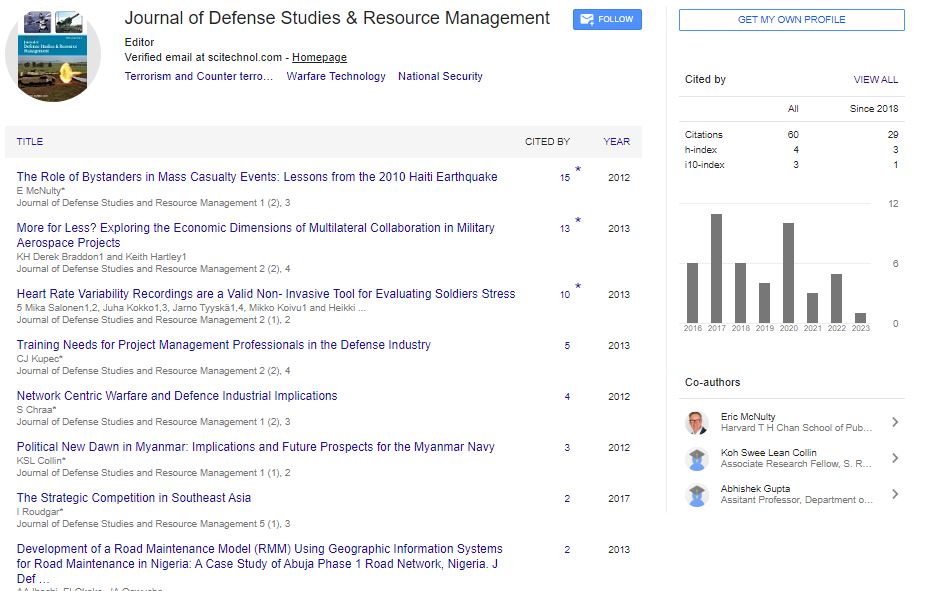Commentary, J Def Stud Resour Manage Vol: 11 Issue: 2
Russia's Strategic Space Defence Measures against American Dominance
Dimitri Welnova*
1Department of Defense Systems, Central Research Institute of Precision Machine Building, Moscow, Russia
*Corresponding Author: Dimitri Welnova,
Department of Defense Systems,
Central Research Institute of Precision Machine Building, Moscow, Russia
E-mail: welnova22@pbu.ru
Received date: 29 May, 2023, Manuscript No. JDSRM-23-107196;
Editor assigned date: 31 May, 2023, PreQC No. JDSRM-23-107196(PQ);
Reviewed date: 14 June, 2023, QC No. JDSRM-23-107196;
Revised date: 22 June, 2023, Manuscript No. JDSRM-23-107196(R);
Published date: 29 June, 2023, DOI: 10.4172/2324-9315.1000181
Citation: Welnova D (2023) Russia's Strategic Space Defence Measures against American Dominance. J Def Stud Resour Manage 11:2.
Abstract
Description
The Cold War era, spanning from the late 1940s to the early 1990s, witnessed a fierce geopolitical rivalry between the United States and the Soviet Union. Space became a critical theater for this competition, symbolizing technological prowess and military supremacy. This article explores Russia's space defense strategy against America during the Cold War, shedding light on their efforts to counter American space initiatives and protect their national security interests. The origins of the Cold War can be traced back to the ideological differences between the United States and the Soviet Union. The United States, advocating for democracy and capitalism, sought to spread its influence and protect its global economic interests. On the other hand, the Soviet Union, led by Joseph Stalin, aimed to expand communism and establish a buffer zone of satellite states in Eastern Europe to protect its borders and influence.
Key events and conflicts
The Cold War was characterized by a series of key events and conflicts that heightened tensions between the two superpowers.
Division of Germany: Following World War II, Germany was divided into two separate entities: West Germany, controlled by the United States, Britain, and France, and East Germany, controlled by the Soviet Union. This division symbolized the ideological split between the two powers.
Korean war: The Korean War (1950-1953) was a major conflict between communist North Korea, supported by China and the Soviet Union, and democratic South Korea, supported by the United States and its allies. The war ended in a stalemate, with the Korean peninsula remaining divided along the 38th parallel.
Cuban missile crisis: In 1962, the world came to the brink of nuclear war during the Cuban Missile Crisis. The Soviet Union had installed nuclear missiles in Cuba, which were discovered by U.S. intelligence. The crisis was defused after tense negotiations between U.S. President John F. Kennedy and Soviet Premier Nikita Khrushchev, with both sides agreeing to remove their missiles.
Arms race: The United States and the Soviet Union engaged in an intense arms race, stockpiling nuclear weapons and developing advanced military technologies. This arms race fueled a constant state of military preparedness and heightened the risk of a global nuclear conflict.
Proxy wars: The Cold War era saw numerous proxy wars fought between the United States and the Soviet Union, where they supported opposing sides in conflicts around the world. Examples include the Vietnam War, where the United States supported South Vietnam against communist North Vietnam, and the Soviet-Afghan War, where the Soviet Union supported the communist government in Afghanistan against rebel forces.
Space race: The United States and the Soviet Union engaged in a competition to achieve milestones in space exploration. The Soviet Union achieved significant early successes, including launching the first satellite, Sputnik, and sending the first human, Yuri Gagarin, into space. The United States countered with the Apollo Moon landing in 1969.
Russia's space defense strategy
Russia, then the Soviet Union, developed a comprehensive space defense strategy against potential American threats. The strategy focused on various aspects.
Anti-Satellite (ASAT) weapons: To counter American space capabilities, the Soviet Union developed anti-satellite weapons. These included direct-ascent missiles and co-orbital systems designed to target and destroy enemy satellites. The goal was to disrupt American communication networks, reconnaissance capabilities, and early warning systems.
Space-based early warning systems: Russia deployed space-based early warning systems to detect and track American missile launches and space activities. These systems utilized satellites equipped with advanced sensors to provide real-time data on potential threats, giving Russia valuable time to respond to any perceived aggression.
Space surveillance and tracking: To ensure awareness of American space activities, Russia developed a robust space surveillance and tracking network. This system involved radar installations, ground-based optical telescopes, and tracking ships to monitor and gather intelligence on American satellites, space probes, and other assets.
Defensive space systems: Russia also pursued the development of defensive space systems, including the use of maneuverable satellites, electronic countermeasures, and anti-jamming technologies. These measures aimed to protect Russian satellites from potential American attacks and disruptions.
Space-based nuclear deterrence: The Soviet Union considered space-based nuclear weapons as a means of deterrence against potential American aggression. Concepts such as orbital nuclear platforms and space-based missile defense systems were explored to bolster Russia's strategic deterrent capabilities.
Conclusion
During the Cold War, Russia, as the Soviet Union, formulated a comprehensive space defense strategy to counter American space initiatives and safeguard its national security interests. Anti-satellite weapons, space-based early warning systems, surveillance and tracking networks, defensive space systems, and space-based nuclear deterrence were key components of Russia's strategy. The space dimension of the Cold War rivalry highlighted the immense importance of space technology for military dominance and showcased the lengths to which both nations were willing to go in their pursuit of superiority.
 Spanish
Spanish  Chinese
Chinese  Russian
Russian  German
German  French
French  Japanese
Japanese  Portuguese
Portuguese  Hindi
Hindi 